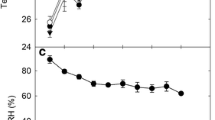Abstract
Rosette-formed, circular thalli of Degelia plumbea were studied in the laboratory. Regardless of thallus size, the optimal quantum yield of photosystem II (F V/F M) remained at a high, constant level during a drying cycle starting with fully hydrated thalli until the thallus water content reached about 200%. Net photosynthesis reached a maximum level at this hydration level. Thereafter, both F V/F M and net photosynthesis fell rapidly to zero at a water content of somewhat less than 100%. There was a highly significant, positive relationship between thallus size and the water-holding capacity, as well as a strong, negative correlation between size and water loss per thallus area. Consequently, an increase in thallus size from 1 to 36 cm2 lead to a tenfold prolongation of the photosynthetically active period during a drying cycle at a low radiation regime. The improved water-holding capacity in larger thalli is mainly a result of a thicker hypothallus. The fast desiccation of small thalli suggests that the regeneration of D. plumbea could be severely hampered by nearby logging that raises the evaporative demand by increasing radiation loads and wind exposure at remaining lichen sites.
Similar content being viewed by others
Author information
Authors and Affiliations
Additional information
Received: 12 December 1997 / Accepted: 20 March 1998
Rights and permissions
About this article
Cite this article
Gauslaa, Y., Solhaug, K. The significance of thallus size for the water economy of the cyanobacterial old-forest lichen Degelia plumbea . Oecologia 116, 76–84 (1998). https://doi.org/10.1007/s004420050565
Issue Date:
DOI: https://doi.org/10.1007/s004420050565




